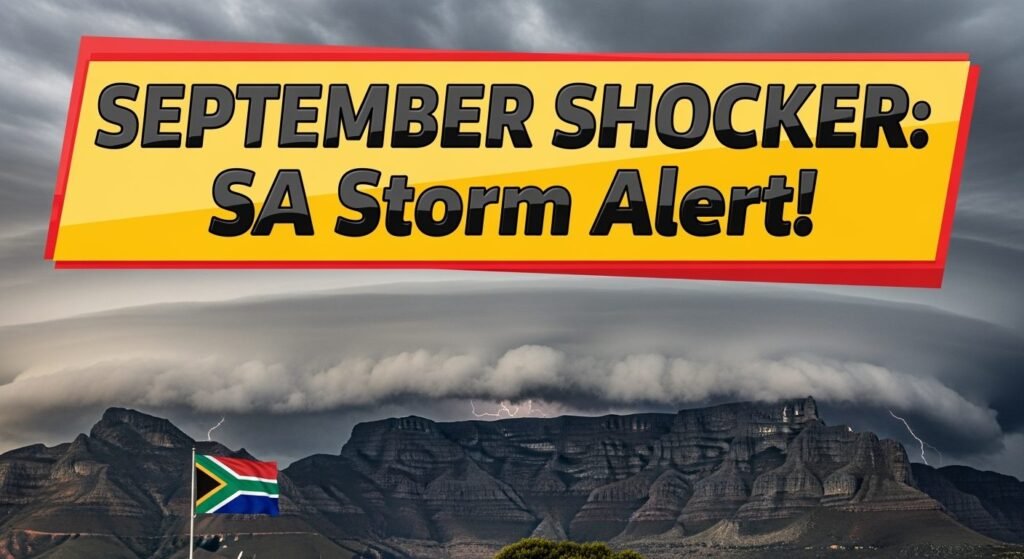South Africa storm warnings: I’ve just received alarming news about severe weather conditions expected to hit various parts of South Africa this September. The national weather service has issued urgent storm warnings, calling for all citizens to take immediate precautionary measures. As we approach what could be a particularly volatile weather period, it’s crucial that you understand the risks and prepare accordingly. These September storm warnings shouldn’t be taken lightly, as meteorological data suggests we could be facing some of the most intense weather systems in recent years. Have you started thinking about how to protect your home and family yet? The time to prepare is now, before the first major systems make landfall.

What Are The September Storm Warnings Telling Us?
The recently released September storm warnings indicate multiple severe weather systems developing that could affect several provinces across South Africa. Meteorologists are tracking intense low-pressure systems that may bring destructive winds exceeding 90 km/h, torrential rainfall potentially exceeding 100mm in 24 hours, and dangerous lightning storms. Coastal areas face additional threats from high seas with waves potentially reaching 6-8 meters in height. The South African Weather Service (SAWS) has specifically highlighted the Western Cape, Eastern Cape, and KwaZulu-Natal as high-risk zones, though other provinces should remain vigilant as well. These warnings represent some of the most serious storm alerts issued in recent years, with officials comparing potential impacts to the devastating floods experienced in previous seasons.
Why These Storm Warnings Require Immediate Attention
I cannot stress enough how critical it is to heed these South Africa storm warnings. Historical data shows that September often marks a transitional period in our weather patterns, creating conditions ripe for extreme events. The combination of warming spring temperatures meeting lingering winter systems creates particularly volatile atmospheric conditions. What makes these warnings especially concerning is the potential for multiple storm systems to affect the same regions in succession, giving communities little time to recover between events. The saturated ground from initial rainfall increases the risk of flooding and landslides during subsequent storms. Additionally, infrastructure weakened by early storms becomes more vulnerable to failure during later events. Emergency services are already operating at capacity due to ongoing challenges, potentially limiting response capabilities during widespread weather emergencies.
How To Prepare For The Forecasted Storms
Preparing for these September storms requires both immediate action and longer-term planning. Start by securing your property – trim overhanging branches, clear gutters and drains, and reinforce any weak structures. Create an emergency kit containing essential supplies for at least 72 hours, including non-perishable food, water, medications, flashlights, batteries, and a first-aid kit. Develop a family communication plan so everyone knows what to do if separated during an emergency. Stay informed by monitoring weather updates through reliable sources like the SAWS website, radio broadcasts, or their official mobile app. Consider purchasing a battery-powered or hand-crank radio to receive updates during power outages. If you live in a flood-prone area, identify evacuation routes and higher ground locations in advance. Remember to include plans for pets and livestock in your preparations.
When To Implement Your Storm Safety Plan
Timing is everything when responding to these South Africa storm warnings. Begin your preparations immediately rather than waiting until storm systems are imminent. The first severe weather events could arrive within days of warnings being issued, leaving little time for last-minute preparations. During the actual storm, stay indoors and away from windows. If authorities issue evacuation orders for your area, leave immediately – don’t delay hoping conditions might improve. After the storm passes, remain cautious. Downed power lines, contaminated water, and weakened structures pose serious hazards. Wait for official clearance before returning to evacuated areas. Continue monitoring weather reports throughout September as multiple storm systems may affect the same regions with little warning. Remember that night storms pose additional dangers due to reduced visibility, so prepare for possible overnight emergencies with appropriate lighting and communication tools.
 Youth Grant September 2025 R12,500 – Full Guide Released for Application Process Across SA
Youth Grant September 2025 R12,500 – Full Guide Released for Application Process Across SA
Real-Life Lessons From Previous Storms
I recently spoke with Johannes Nkosi from KwaZulu-Natal, who experienced devastating floods last year. “We thought we were prepared, but the storm intensity caught us off guard,” he explained. “What saved us was having an emergency bag ready with documents, medications, and essentials. We also had established a neighborhood WhatsApp group where we shared real-time updates about rising water levels.” Johannes emphasized the importance of charging all devices before storms hit and investing in power banks. His family now keeps emergency supplies in waterproof containers stored on upper floors, a simple step that prevented critical losses during subsequent flooding. These practical measures demonstrate how proper preparation can significantly reduce storm impacts on families and communities.



